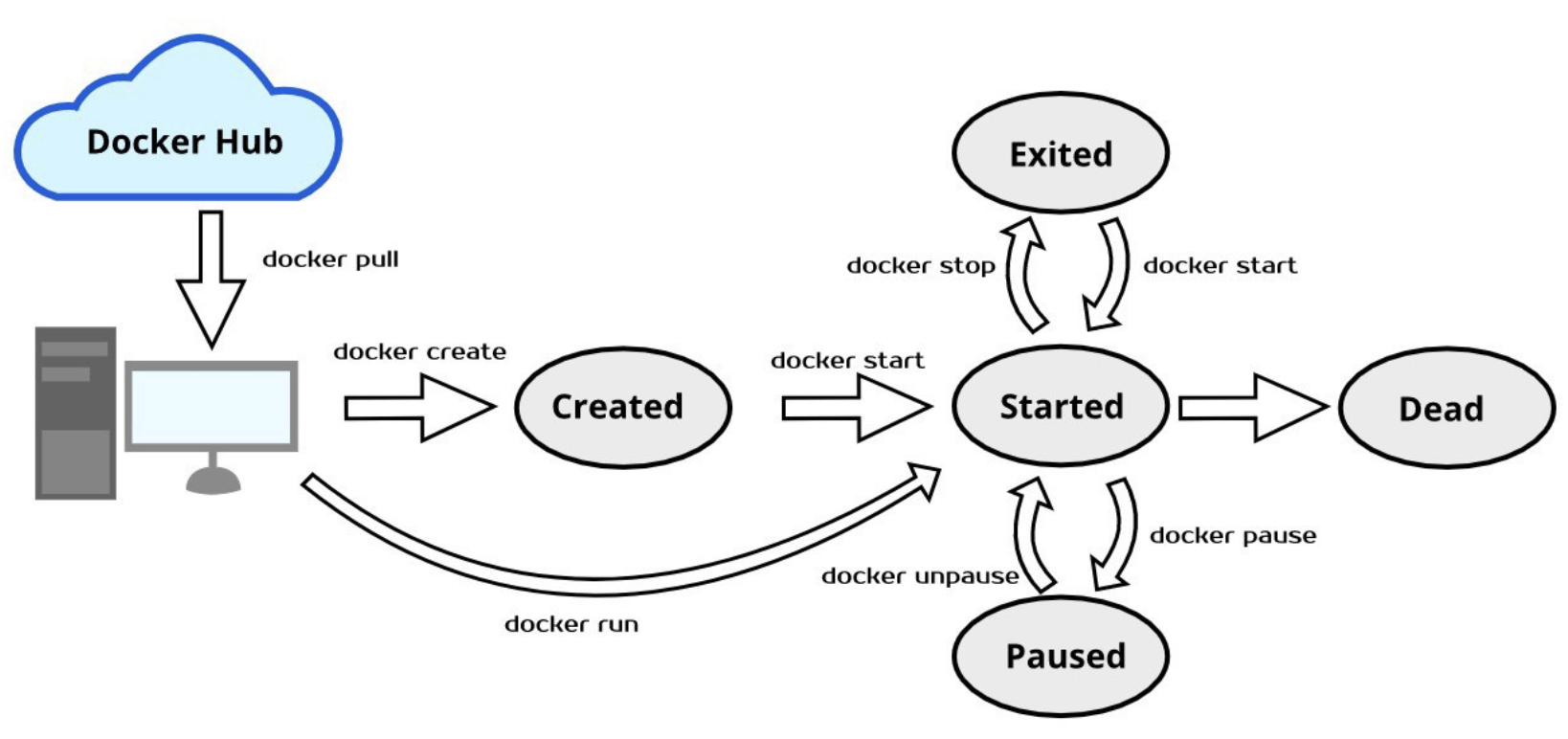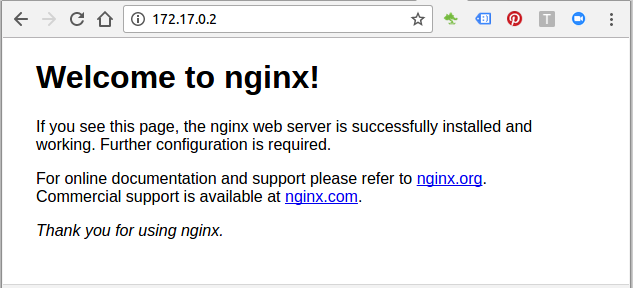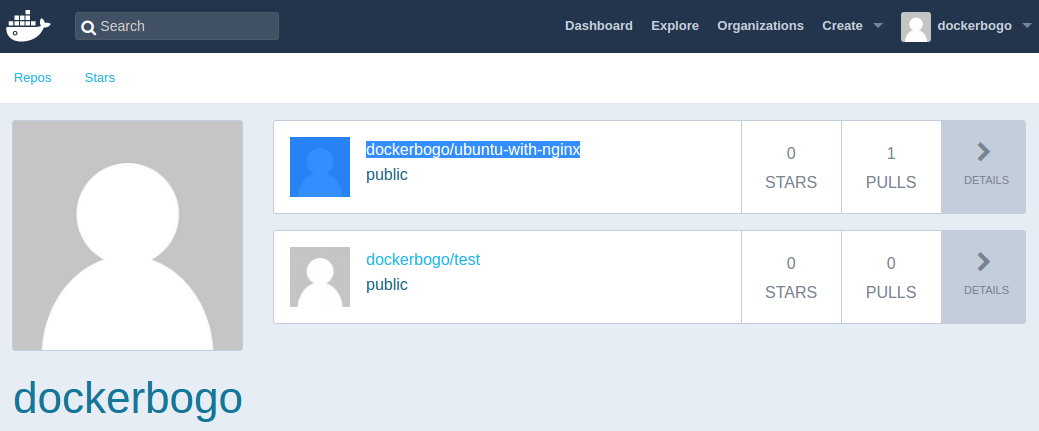Container is runtime environments for an image. When we do docker pull <image>, the container is not started nor created yet.
We most commonly used command is the docker run <image> command. It downloads the image if it's not already in our local machine and starts the container once the image is ready.
- docker create: creates a writable container layer over the
specified image and prepares it for running the specified command. The
container ID is then printed to STDOUT. This is similar to docker run -d except the container is never started. We can then use the docker start <container_id> command to start the container at any point.
$ docker create -t -i fedora bash ... dff32a272ad4c94cd51419ee4f53c371e3c3a8cfb448a469634d4420e139d118 $ docker start -a -i dff32a272ad4c [root@dff32a272ad4 /]#
i: interactive, keep STDIN open even if not attached
t: Allocate a pseudo-TTY
a: Attach container's STDOUT and STDERR and forward all signals to the process.
- docker rename allows the container to be renamed.
- docker run creates and starts a container in one operation.
- docker rm deletes a container.
- docker update updates a container's resource limits. Example : updating multiple resource configurations for multiple containers:
$ docker rename my_container my_new_container
$ docker run -it ubuntu-ssh-k /bin/bash
$ docker rm myfedora
$ docker update --cpu-shares 512 -m 300M dff32a272ad4 happy_kare
dff32a272ad4
happy_kare
- docker ps shows running containers.
- docker logs gets logs from container. (We can use a custom log driver, but logs is only available for json-file and journald in 1.10)
- docker inspect looks at all the info on a container (including IP address). To get an IP address of a running container:
- docker events gets events from container.
- docker port shows public facing port of container.
- docker top shows running processes in container.
- docker stats shows containers' resource usage statistics.
- docker diff shows changed files in the container's FS.
$ docker ps
CONTAINER ID IMAGE COMMAND CREATED STATUS PORTS NAMES
e2481c1bad5d ubuntu-ssh-k:latest "/bin/bash" 10 hours ago Up 10 hours hopeful_carson
$ docker logs 839f66a78983
$ docker inspect --format '{{ .NetworkSettings.IPAddress }}' $(docker ps -q)
172.17.0.5

Picture credit: Get Started with Docker Lifecycle
- docker start starts a container so it is running.
- docker stop stops a running container.
- docker restart stops and starts a container.
- docker pause pauses a running container, "freezing" it in place.
- docker unpause will unpause a running container.
- docker wait blocks until running container stops.
- docker kill sends a SIGKILL to a running container.
- docker attach will connect to a running container.
Or we can use the following to get tty:$ docker exec -i -t my-nginx-1 /bin/bash
Note that we used exec to run a command in a "running" container!
- docker images : shows all images.
- docker import : creates an image from a tarball.
- docker build : creates image from Dockerfile.
- docker commit : creates image from a container, by default, the container being committed and its processes will be paused while the image is committed. This reduces the likelihood of encountering data corruption during the process of creating the commit. As an example, let's install nginx to the ubuntu container:
- -m 'added nginx start' creates a comment for this commit.
- --change='CMD ... is changing the CMD command, which is what the image will run when it is first started up. In this example, we are telling the image to run nginx in the foreground. Most base os images have CMD set to bash so we can interact with the os when attaching.
- We used "EXPOSE" to get the port exposed to the host.
- "9644a814e95a" is the name of the container we want to commit from.
- "ubuntu-nginx:version2" is our name for the new image. We appended version to the name of the container.
- docker rmi : removes (and un-tags) an image from the host node. If an image has multiple tags, using this command with the tag as a parameter only removes the tag. If the tag is the only one for the image, both the image and the tag are removed. This does not remove images from a registry. We cannot remove an image of a running container unless we use the -f option.
- docker load : loads an image from a tar archive as STDIN, including images and tags .
- docker save : saves an image to a tar archive stream to STDOUT with all parent layers, tags & versions .
$ docker run -it ubuntu /bin/bash
root@bf5d24821dfa:/# apt-get update
root@bf5d24821dfa:/# apt-get install nginx
While the container is running, on another terminal, we can commit the change to another image:
$ docker ps CONTAINER ID IMAGE COMMAND bf5d24821dfa ubuntu "/bin/bash" $ docker commit bf5d24821dfa ubuntu-nginx $ docker images REPOSITORY TAG IMAGE ID ubuntu-nginx latest 91cc8b745f5e $ docker run -it ubuntu-nginx root@9644a814e95a:/# $ docker ps CONTAINER ID IMAGE COMMAND 9644a814e95a ubuntu-nginx "/bin/bash" bf5d24821dfa ubuntu "/bin/bash"
Note the the new container dit not start "nginx" server. So, we can commit a container with new CMD and EXPOSE instructions:
root@9644a814e95a:/# exit
$ docker commit -m 'added nginx start' --change='CMD ["nginx", "-g daemon off;"]' -c "EXPOSE 80" 9644a814e95a ubuntu-nginx:version2
We can now view our new image with the following command:
$ docker images
REPOSITORY TAG IMAGE ID
ubuntu-nginx version2 61918a284221
Run the new image:
$ docker run -idt ubuntu-nginx:version2 $ ps aux | grep -v grep |grep nginx root 12546 0.0 0.2 124972 9560 pts/25 Ss+ 10:21 0:00 nginx: master process nginx -g daemon off; www-data 12565 0.0 0.0 125332 3040 pts/25 S+ 10:21 0:00 nginx: worker process www-data 12566 0.0 0.0 125332 3040 pts/25 S+ 10:21 0:00 nginx: worker process $ docker inspect --format '{{ .NetworkSettings.IPAddress }}' $(docker ps -q) 172.17.0.2
We can see the index page:

- docker history shows history of image.
- docker tag tags an image to a name (local or registry).
- docker network create
- docker network rm
- docker network ls
- docker network inspect
- docker network connect
- docker network disconnect
- docker login to login to a registry. (see docker push)
- docker logout to logout from a registry.
- docker search searches registry for image.
- docker pull pulls an image from registry to local machine.
- docker push pushes an image to the registry from local machine. First, we'll install nginx on top of ubuntu, and then commit it. After login to DockerHub, we'll tag the image and push it:
$ docker login --username=dockerbogo Password: Login Succeeded
$ docker logout
Removing login credentials for https://index.docker.io/v1/
$ docker search mysql
NAME DESCRIPTION STARS OFFICIAL AUTOMATED
mysql MySQL is a widely used, open-source relati... 2797 [OK]
mysql/mysql-server Optimized MySQL Server Docker images. Crea... 182 [OK]
...
$ docker pull ubuntu
latest: Pulling from ubuntu
20ee58809289: Pull complete
f905badeb558: Pull complete
119df6bf2a3a: Pull complete
94d6eea646bc: Pull complete
bb4eabee84bf: Pull complete
Digest: sha256:85af8b61adffea165e84e47e0034923ec237754a208501fce5dbeecbb197062c
Status: Downloaded newer image for ubuntu:latest
Docker images can consist of multiple layers. In the example above, the image consists of five layers.
$ docker run -it ubuntu:latest /bin/bash root@846346c3482f:/# apt-get update root@846346c3482f:/# apt-get install nginx $ docker commit 846346c3482f ubuntu-with-nginx $ docker images REPOSITORY TAG IMAGE ID CREATED SIZE ubuntu-with-nginx latest de412f7faba5 16 minutes ago 212 MB $ docker login --username=dockerbogo Password: Login Succeeded $ docker tag de412f7faba5 dockerbogo/ubuntu-with-nginx:myfirstpush $ docker push dockerbogo/ubuntu-with-nginx:myfirstpush The push refers to a repository [docker.io/dockerbogo/ubuntu-with-nginx] 44f391d61c42: Pushed 73e5d2de6e3e: Mounted from library/ubuntu 08f405d988e4: Mounted from library/ubuntu 511ddc11cf68: Mounted from library/ubuntu a1a54d352248: Mounted from library/ubuntu 9d3227c1793b: Mounted from library/ubuntu myfirstpush: digest: sha256:a24d914b8e3a013987314054b2c2409e99c00384342b25ee7dba4c51cb1ea49a size: 1569
We can check if the push was successful:

On Max, the containers are stored within the VM located at:
$ ls -la ~/Library/Containers/com.docker.docker/Data/vms/0
total 16215008
drwxr-xr-x@ 17 kihyuckhong staff 544 Dec 16 10:42 .
drwxr-xr-x 3 kihyuckhong staff 96 Jul 31 15:03 ..
srwxr-xr-x 1 kihyuckhong staff 0 Dec 16 10:41 00000002.000005f4
srwxr-xr-x 1 kihyuckhong staff 0 Dec 16 10:41 00000002.00001001
srwxr-xr-x 1 kihyuckhong staff 0 Dec 16 10:41 00000002.00001003
srwxr-xr-x 1 kihyuckhong staff 0 Dec 16 10:41 00000003.000005f5
srwxr-xr-x 1 kihyuckhong staff 0 Dec 16 10:41 00000003.00000948
-rw-r--r-- 1 kihyuckhong staff 8331264000 Dec 20 16:46 Docker.qcow2
-rw-r--r-- 1 kihyuckhong staff 90112 Dec 16 10:41 config.iso
srwxr-xr-x 1 kihyuckhong staff 0 Dec 16 10:41 connect
drwxr-xr-x 2 kihyuckhong staff 64 Aug 5 20:31 data
lrwxr-xr-x 1 kihyuckhong staff 17 Dec 16 10:41 guest.000005f5 -> 00000003.000005f5
lrwxr-xr-x 1 kihyuckhong staff 17 Dec 16 10:41 guest.00000948 -> 00000003.00000948
-rw-r--r-- 1 kihyuckhong staff 2764 Dec 16 10:41 hyperkit.json
-rw-r--r-- 1 kihyuckhong staff 3 Dec 16 10:41 hyperkit.pid
drwxr-xr-x 2 kihyuckhong staff 64 Jul 31 15:03 log
lrwxr-xr-x 1 kihyuckhong staff 12 Dec 16 10:41 tty -> /dev/ttys004
$ screen ~/Library/Containers/com.docker.docker/Data/vms/0/tty
The command will show a blank window, just hit "Enter", then we get:
docker-desktop:~# docker-desktop:~# cd /var/lib/docker docker-desktop:/var/lib/docker# ls -la total 124 drwx--x--x 15 root root 4096 Dec 16 18:42 . drwxr-xr-x 10 root root 4096 Jul 31 22:03 .. drwx------ 2 root root 4096 Jul 31 22:03 builder drwx--x--x 4 root root 4096 Jul 31 22:03 buildkit drwx------ 3 root root 4096 Jul 31 22:03 containerd drwx------ 10 root root 4096 Dec 20 20:34 containers drwx------ 3 root root 4096 Jul 31 22:03 image drwxr-x--- 3 root root 4096 Jul 31 22:03 network drwx------ 80 root root 49152 Dec 20 20:34 overlay2 drwx------ 4 root root 4096 Jul 31 22:03 plugins drwx------ 2 root root 4096 Dec 16 18:42 runtimes drwx------ 2 root root 4096 Jul 31 22:03 swarm drwx------ 2 root root 4096 Dec 16 18:42 tmp drwx------ 2 root root 4096 Jul 31 22:03 trust drwx------ 14 root root 20480 Dec 15 18:43 volumes
Additional steps with a screen command:
# disconnect that session but leave it open in background Ctrl-a d # list that session that's still running in background $ screen -ls There is a screen on: 18887.ttys005.Kihyucks-MacBook-Air (Detached) 1 Socket in /var/folders/3s/42rgkz495lj4ydjgnqhxn_400000gn/T/.screen. # reconnect to that session (don't open a new one, that won't work and 2nd tty will give you garbled screen) $ screen -r 18887.ttys005.Kihyucks-MacBook-Air [screen is terminating] # kill this session (window) and exit Ctrl-a k
https://docs.docker.com/engine/reference/commandline/docker/